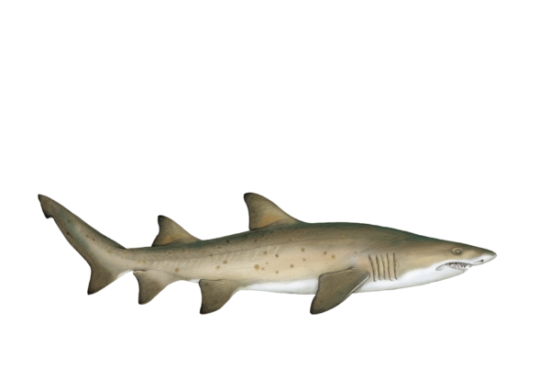
Share Your Sand Tiger Shark Images
What Is Spot A Shark?
A Shark USA is a citizen-science program that engages anyone who spends time on the water in
sand tiger shark research along the Atlantic coast. Divers, snorkelers, and others are asked to
photograph encounters with sand tiger sharks and post their images to the Spot A Shark USA website.
Scientists then use unique spot patterns visible along the sides of the photographed sharks to identify
individual animals. Identifying individual sand tiger sharks helps track shark movement and behavior
over time. It also determines which coastal habitats sand tiger sharks use during their lives. This
information is used by Spot A Shark USA researchers, as well as international partners, to facilitate
management decisions aimed towards conserving sand tiger sharks, which are critically endangered in
several parts of the world.
About the Species
Sand tiger sharks
(Carcharias taurus)
are highly-migratory, large coastal sharks found in many
parts of the world. These sharks, which primarily eat fish, rays, and small sharks, have several
prominent, identifying features, such as brown spots on their sides that help distinguish
individuals and an iconic ‘ragged-tooth’ smile, making them ideal subjects for underwater
photographers. Along the east coast of the US, sand tiger sharks often occur in large
aggregations of 20-80 individuals. They are about 3 ft long at birth and can grow to 10
ft as adults. Sand tiger sharks often appear to hover motionless because they control
their buoyancy using not only their large, oily liver, but also air that they gulp from
the surface.
Sand Tiger Habits
While sand tiger sharks are known to occur in a variety of shallow coastal habitats, little is known about which habitats sand tiger sharks in the northwestern Atlantic use during their different life phases.
Pups: It is not known where sand tiger sharks give birth to their pups. Our team is conducting research to locate sand tiger shark pupping grounds.
Juveniles: Juvenile sand tiger sharks of ~1-2 years old use northern estuaries, such as Long Island Sound, as nursery grounds. Generally, juvenile sand tiger sharks spend summertime in these northern nurseries, and when the season shifts, they migrate south to wintertime habitats.
Adults: Adults are presumed to migrate seasonally between northern summertime and southern wintertime habitats, although some sharks may use habitats off North Carolina, USA as year-round habitat.
Sand tiger sharks often occur in aggregations of 20 to 80 individual sand tigers, and likely contain complex social networks. Important unanswered questions remain regarding how sand tiger sharks use coastal habitats. Images uploaded to Spot A Shark USA will help fill these knowledge gaps about what habitats sand tiger sharks use over time.
Pups: It is not known where sand tiger sharks give birth to their pups. Our team is conducting research to locate sand tiger shark pupping grounds.
Juveniles: Juvenile sand tiger sharks of ~1-2 years old use northern estuaries, such as Long Island Sound, as nursery grounds. Generally, juvenile sand tiger sharks spend summertime in these northern nurseries, and when the season shifts, they migrate south to wintertime habitats.
Adults: Adults are presumed to migrate seasonally between northern summertime and southern wintertime habitats, although some sharks may use habitats off North Carolina, USA as year-round habitat.
Sand tiger sharks often occur in aggregations of 20 to 80 individual sand tigers, and likely contain complex social networks. Important unanswered questions remain regarding how sand tiger sharks use coastal habitats. Images uploaded to Spot A Shark USA will help fill these knowledge gaps about what habitats sand tiger sharks use over time.
Sand Tiger Reproduction
Sand tiger sharks have one of the lowest reproductive rates among sharks because they exhibit delayed sexual maturity (6-7 years for males, 9-10 years for females), have a long gestation time (9-12 months), and produce 1-2 pups every several years. Unlike other sharks, female sand tigers have two uteri. Within each uterus, intrauterine cannibalism, where larger pups consume weaker siblings in the womb, occurs. The slow and unique reproductive strategy of sand tiger sharks, which may live up to 17 years in the wild and over 25 years in human care, makes sustaining populations of these sharks challenging. Data gathered with Spot A Shark USA will provide important clues as to where and when these sharks are mating, breeding, and giving birth.
Distinguishing Individuals
Life Phase : Juvenile and adult sand tiger sharks can be distinguished by their size. Juveniles are smaller than adults, with < 4 feet length, whereas adults are larger with > 4 feet fork length. The fork length is the distance from the snout to the base of the caudal fin.
Sex: While male sharks are usually smaller than female sharks, the best way to tell a male from a female is by looking at the underside of the shark. Male sharks have appendages called claspers on their underside. Claspers are modified pelvic fins that are used to insert sperm into female sharks during mating. In contrast, female sand tiger sharks do not have claspers.
Sex: While male sharks are usually smaller than female sharks, the best way to tell a male from a female is by looking at the underside of the shark. Male sharks have appendages called claspers on their underside. Claspers are modified pelvic fins that are used to insert sperm into female sharks during mating. In contrast, female sand tiger sharks do not have claspers.
Species Conservation
Sharks are marvels of natural selection with remarkable adaptations that evolved over 400 million years
to play a critical role in marine food webs and ocean health. Our understanding of sharks is ever evolving.
Active research projects, such as Spot A Shark USA, assist scientists in gaining valuable information to
support effective, science-based conservation for shark species, such as sand tiger sharks.
Due to overfishing, numbers of sand tiger sharks have declined globally. In some locations, sand tiger sharks
are listed as “critically endangered.” In the northwest Atlantic Ocean, for example, the species is listed as
“vulnerable.” By supporting this project, you are helping researchers and the NC Aquariums gather valuable data,
which may help provide long-term protection for sand tiger sharks and their habitats.
2025 All Rights Reserved | For more information contact Spot A Shark USA
User Agreement | References
• Wildbook v.6.0.0-EXPERIMENTAL software is distributed under GPL v2 license and is intended to support mark-recapture field studies.
Website by the friendly folks at Tracks Data Solutions.










